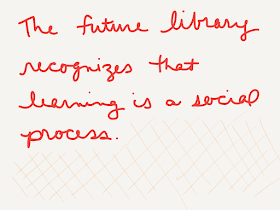In November, I facilitated a POP! program on the topic of Screen Time--specifically new media (like tablets and smartphones), although we did talk about television, too. After a bit of social time in which the attending parents and I chatted about their kids, what the kids like to do, and questions about media, I shared some information from experts followed by some recommendations for screen time and their preschool-age children. We also ended the last fifteen minutes of the program with a hands-on exploration of some exemplary apps. Here's what we discussed.
Expert Recommendations
According to the American Academy of Pediatrics, co-engagement counts when it comes to media use. That means using media along with your child, for example in the same ways that you would read a book together. Additionally, parents should be aware that screen-free playtime is important, too, and make time to engage in that type of open play.According to Lisa Guernsey, author of Screen Time and Tap Click Read, parents should consider the 3 Cs when considering media use: Content, Context, and the Child. Content refers to the specific type of media and what it includes. Context refers to how, when, and why the media is being used--for example, because a child wants to look at pictures of zoo animals or because a child appears bored. The child refers to the parent's knowing their child and their needs best, and making media decisions with their child in mind.
According to the National Association for the Education of Young Children and the Fred Rogers Center, the media use should be active, hands-on, engaging, and empowering.
When using media with a young child (age 2-5)...
Choose high-quality apps. This means avoiding distracting noises and actions, glitchy performance, and in-app purchases. A good rule of thumb for quality is whether you, the adult, can stand to use it with your child for five minutes or more.Use media together. Children learn through interaction, so the process of reading, playing, and creating together allows them to learn new concepts, new words, and how media work.
Build relationships using media. Commemorate family outings, videochat long-distance relatives, and work together to strengthen bonds.
Don't be too hard on yourself. There are lots of messages out there about children and screen time. Remember that you know your child best, and that occasional screen time that isn't ideal isn't the end of the world.
Tips for Reading, Playing, and Creating Together with New Media
Ask questions when you read a digital story. For example, ask, "What do you think will happen next?"Reread a favorite digital story together and tell it yourself.
Practice saying new words and learn their meanings while you read digital stories.
Explore new experiences using media, including ones you couldn't ordinarily have in your everyday life (like looking at pictures of desert animals if you live in a temperate area, etc.).
Videochat faraway friends.
Record your child telling a story or talking about a creation.
Make a photo show of pictures from a family outing.
~~*~~
This program, at its core, is an example of media mentorship: it equips parents with expert information about young children and screen time, effectively allowing them to make the best possible decisions about screen time for their children and their family. I emphasized that every family and every child is different, so what screen time looks like at one house may not resemble what it looks like at another. And that's fine--what's important is that parents feel confident in making choices they feel are right for them and their families. And based on the post-program surveys, the parents who attended POP! Parents of Preschoolers: Screen Time did feel more confident in doing so following the program.










































